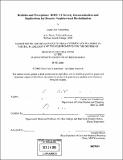Realities and perceptions : HOPE VI poverty deconcentration and implications for broader neighborhood revitalization
Author(s)
Vanderford, Carrie Ann
DownloadFull printable version (17.46Mb)
Alternative title
HOPE VI poverty deconcentration and implications for broader neighborhood revitalization
Other Contributors
Massachusetts Institute of Technology. Dept. of Urban Studies and Planning.
Advisor
Lawrence J. Vale.
Terms of use
Metadata
Show full item recordAbstract
HOPE VI was developed in 1992 as program to demolish and revitalize the nation's most severely distressed public housing. One element of the HOPE VI program is to move low-income households out of an environment of concentrated poverty and replace distressed public housing with a development that includes a variety of incomes, where the number and density of households in poverty is decreased. This policy of "poverty deconcentration" is now accepted and practiced by housing authorities as part of a greater prescription for neighborhood revitalization. However, there is little evidence to prove the merits of HOPE VI poverty deconcentration as a catalyst in neighborhood revitalization. The focus of this thesis is to further define the link between policies of poverty deconcentration and neighborhood revitalization while offering insight about the expected long-term benefit of this policy for future HOPE VI planning. The two housing authorities responsible for developing Mandela Gateway in Oakland, California and Posadas Sentinel in Tucson, Arizona aimed to achieve the HOPE VI mandate of poverty deconcentration through two strategies. For this thesis, these strategies are categorized as development-based poverty dilution and neighborhood-based poverty dispersal, respectively. (cont.) This thesis relies upon interviews with key informants, document review, and some analysis of land use patterns in neighborhoods surrounding HOPE VI developments to investigate causality between two methods of HOPE VI poverty deconcentration and broader neighborhood revitalization. The main conclusions of this thesis are drawn from the interaction between the policies and practices of the local public housing authority and other public and private investors in the broader neighborhood. Overall, this thesis finds that HOPE VI poverty deconcentration strategies alone are not enough to affect broader neighborhood revitalization, but are a critical element in changing the perception of public and private investors as they contemplate investment around the development. In both cases the poverty deconcentration strategy was implemented in a way that harnessed existing market forces for neighborhood revitalization. This thesis concludes with a discussion of the best practices to advance the critical goals of HOPE VI poverty deconcentration and offers anagenda for further research.
Description
Thesis (M.C.P.)--Massachusetts Institute of Technology, Dept. of Urban Studies and Planning, 2006. Includes bibliographical references (p. 138-140).
Date issued
2006Department
Massachusetts Institute of Technology. Department of Urban Studies and PlanningPublisher
Massachusetts Institute of Technology
Keywords
Urban Studies and Planning.